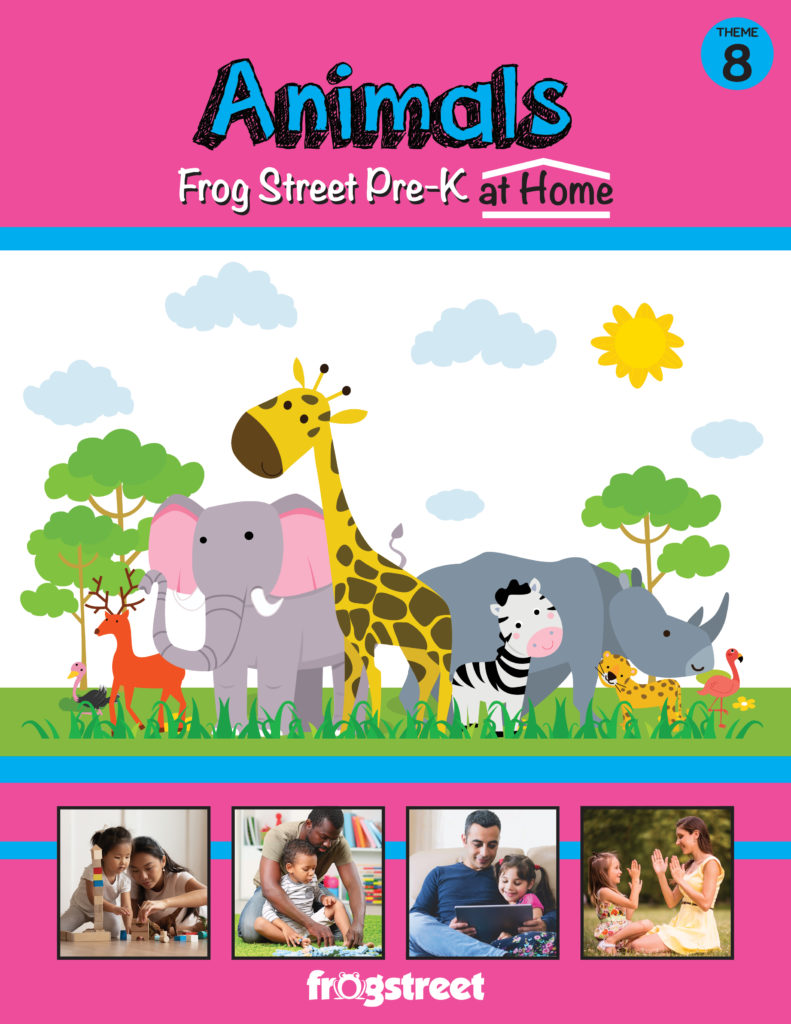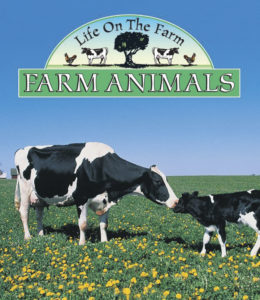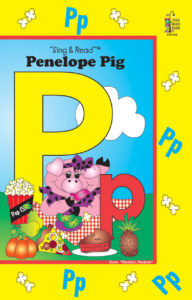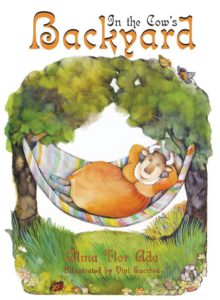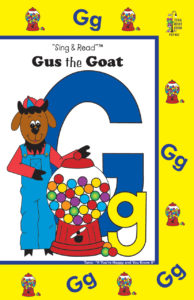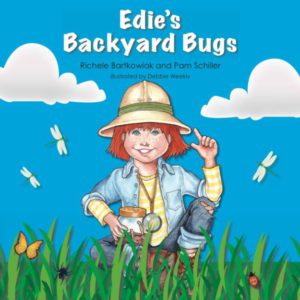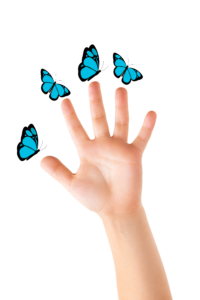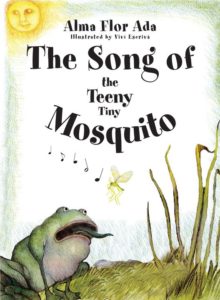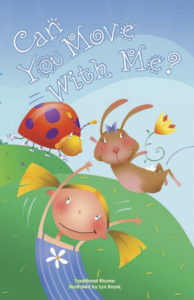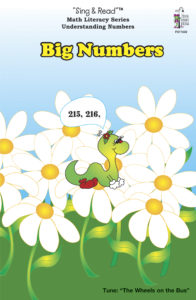This week your child will explore farm animals—their sounds and movements, as well as their habits and unique characteristics.
Ear Rub
Teach your child this calming strategy. It is easy to do in crowded areas or when seated.
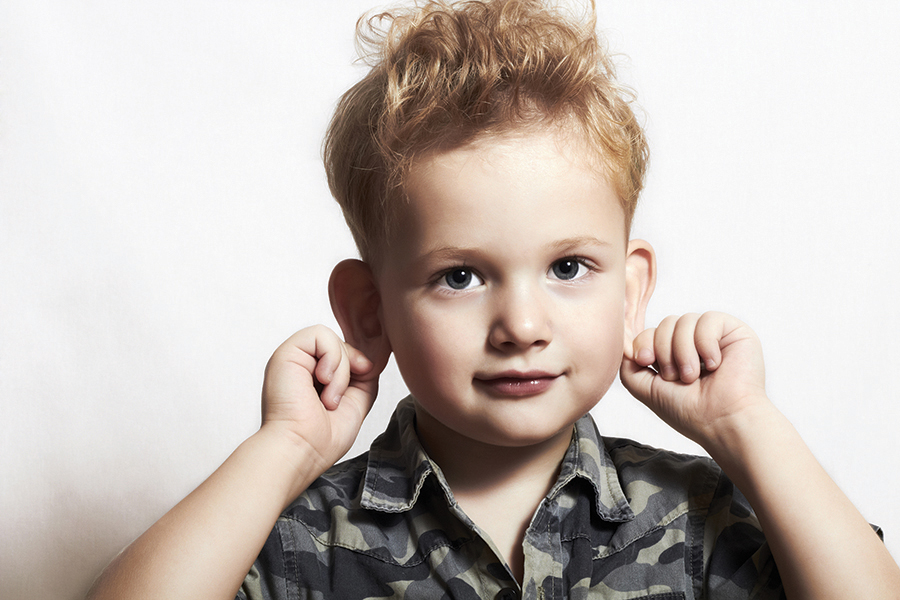
- Gently massage your ear lobes.
- Slowly inhale and exhale.
Ask: When would you use a calming strategy like this one?
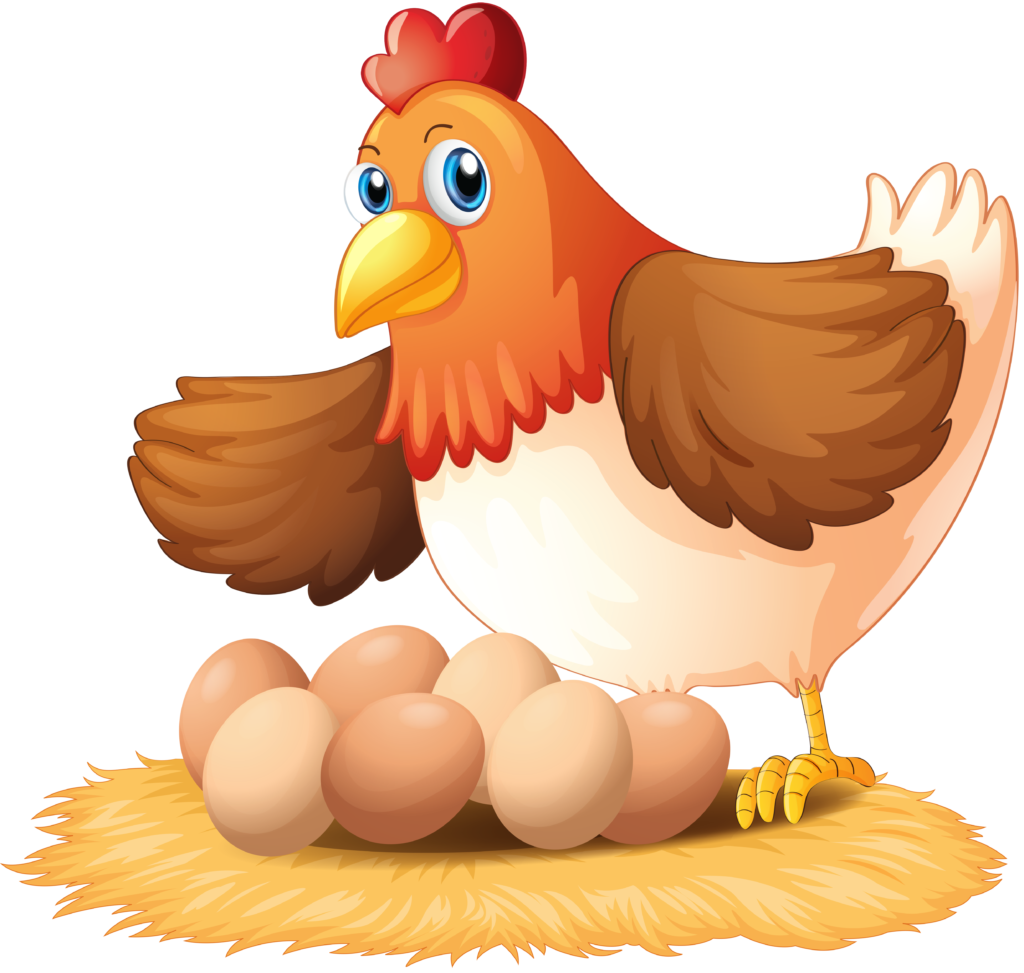
Model the Story
Tell your child the following number story: Yesterday, Old MacDonald went out to the hen house. He found three eggs. Today, he found four more eggs. Have your child retell the number story. Use plastic eggs or rocks (counters) for your child to model and act out the story. Ask: How many eggs have Old MacDonald’s hens laid altogether? Count the eggs to confirm the correct answer.
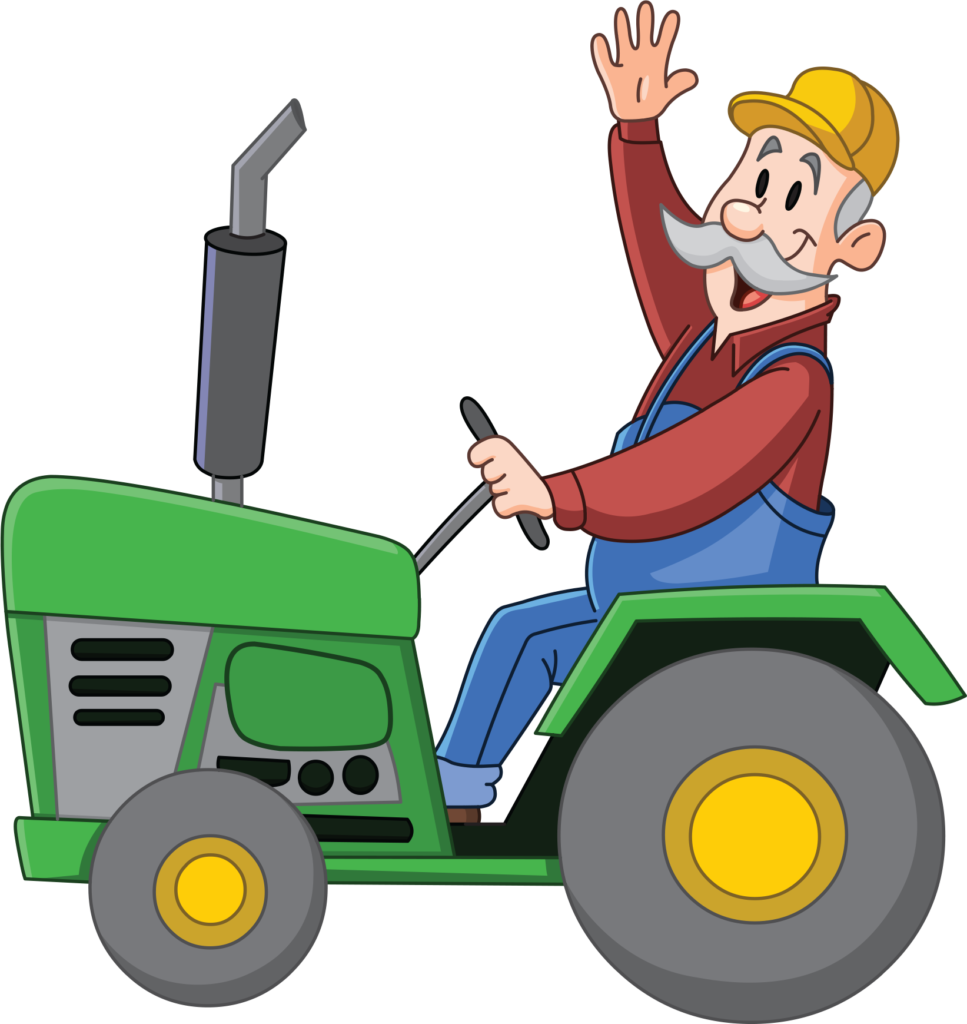
“Farmer in the Dell”
The person who cares for animals on a farm is the farmer. Often all of the family members who live on a farm help with farm tasks. Brainstorm some of the tasks that farmers would need to do. Listen to the song and enjoy acting out the different characters mentioned. Ask: Which farm character would you like to be? Note: The rhythm of this song is great for practicing skipping.
Reading with your child
Farm Animals
Show the book cover. Say: This book is an informational book about farm animals. Show the Table of Contents on page 3. Remind your child that the Table of Contents tells the reader where to find information. Point to Farm Animals in the Table of Contents. Take a picture walk through this section of the book. Have your child identify the animals. Read pages 5-9. Talk briefly about any experiences your child has had with farm animals.
Listen and Write
For the next five weeks you and your child will be saying the names and sounds of letters and practicing writing letters.
- Say the message and then write the sentence: Animal begins with A.
- Have your child practice saying the letter name and sound. (A, /a/ as in cat)
- Model writing the letter.
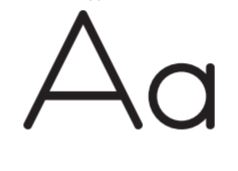
A (slant down, slant down, slide across)
a (circle around and up, pull down)
- Have your child practice writing the letter in the air or on the floor.
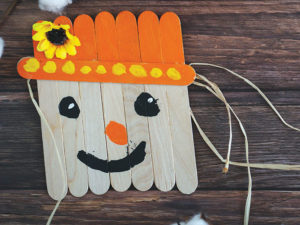
A Scarecrow Face
Birds, like crows, eat the seeds and crops that farmers plant. In order to protect their crops, farmers build scarecrows in their fields. Make this scarecrow.
- Glue seven craft sticks or strips of brown paper in a row on a piece of cardboard.
- Glue an eighth stick diagonally near the top for the scarecrow’s hat.
- Color the diagonal stick and the hat (portion above the stick) using markers or paint.
- Add eyes, nose, and a smile.
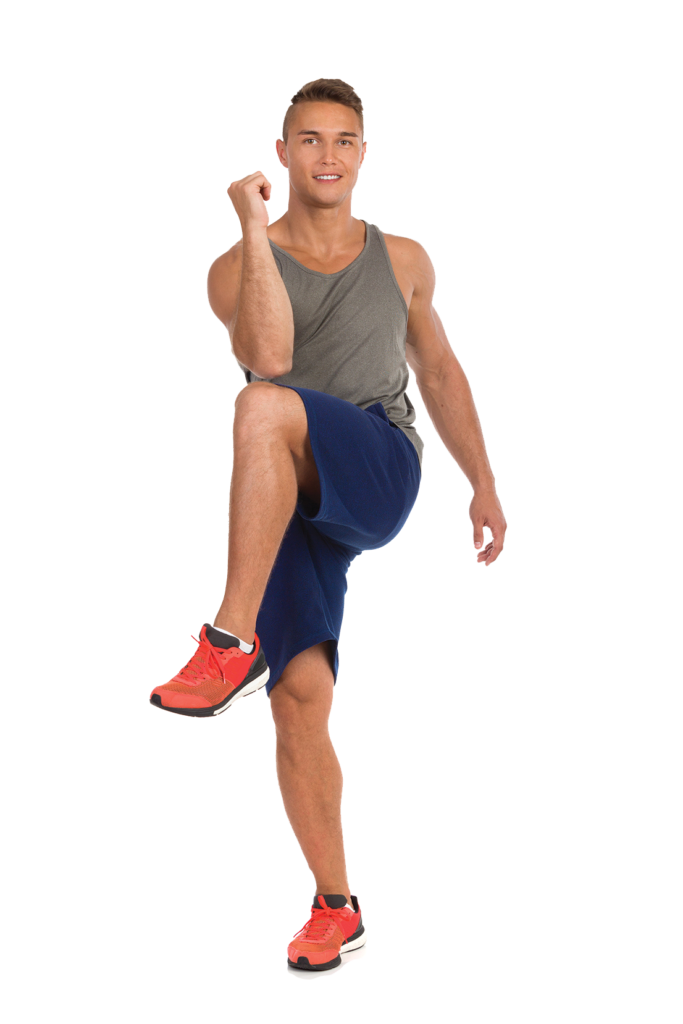
Crisscross
Crossing the midline of the body energizes thinking. Do these simple elbow-knee touches standing or lying on the floor.
- Lower your right elbow across your body.
- Raise your left knee until the elbow and knee touch.
- Repeat with the left elbow and right knee.
- Do ten of each cross.
Illustrate the Story
Remind your child about the egg number story you did together yesterday. Talk with your child about how you could draw pictures (illustrate) the beginning (hens laid three eggs), middle (hens laid four more eggs), and the end (seven eggs all together). Ask: How did the numbers of eggs change from the beginning to the end? (amount increased or got bigger) Draw the illustrations on a strip of paper folded into three sections. Save the drawing for tomorrow.

“Five Little Ducks”
Enjoy listening to this song about a family of ducks. Then squat down, flap your wings, and act out the verses as you “duck walk” over the hills and then swim back home.

Reading with your child
Farm Animals
Show the cover of the book. Explain that today you will read about poultry. Poultry is the name for birds that live on a farm (chickens, ducks, turkeys). Find the chapter on poultry in the Table of Contents. Turn to page 18. Encourage your child to name the birds in the photos as you read. Point out the captions by each photo. A caption is an explanation of a photo. It is usually printed in small type and is found beside or below a picture. Reading captions is a good way to get information.
Listen and Write
- Say: Farm begins with F. Then write the sentence.
- Have your child practice saying the letter name and sound.
- Model writing the letter.
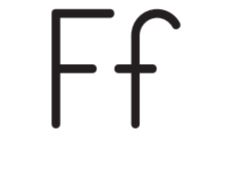
F (pull down, slide across, slide across)
f (circle around and pull down, slide across)
- Have your child practice writing the letter in the air or on the floor.
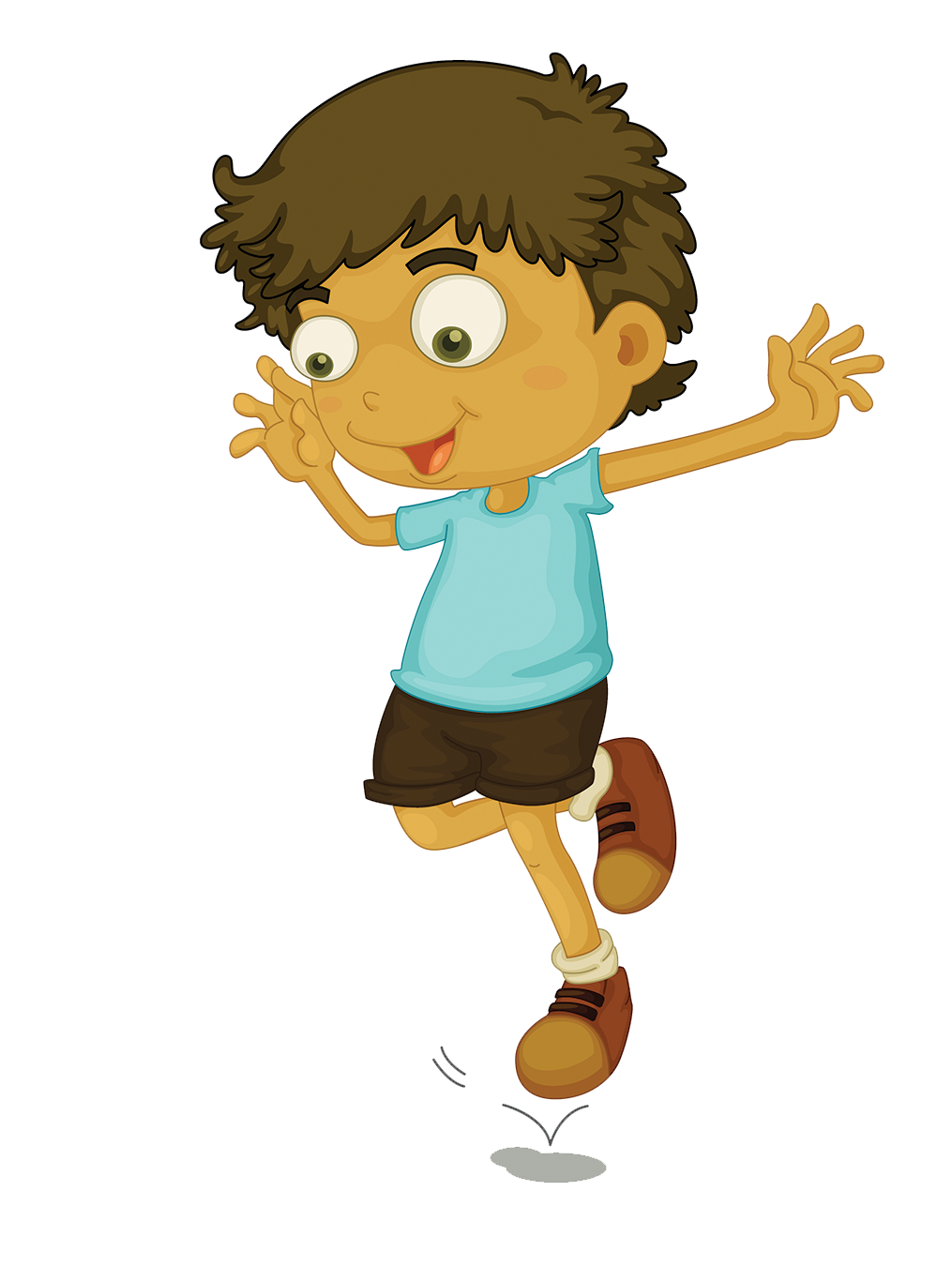
Hopping Chicken
Place five paint stirrers or beanbags (about one foot apart) in a line on the floor. Have your child become a hopping chicken and hop over them in this game:
- Hop over the sticks one at a time.
- Turn around after you reach the end.
- Pick up the last stick and hop back.
- Take turns hopping until all the sticks have been picked up.
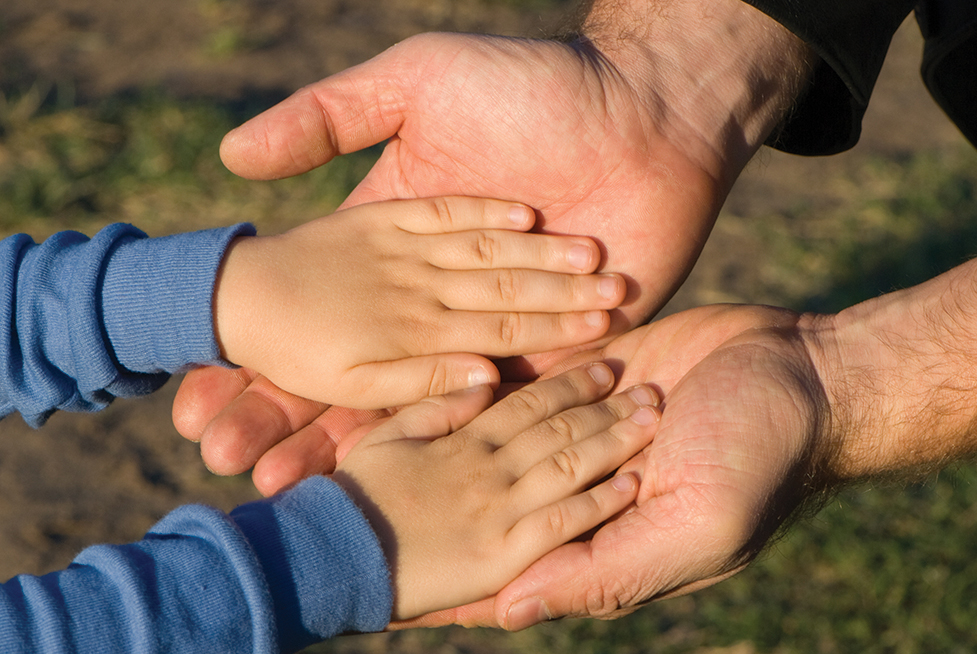
To Market, To Market
Extend your hands (palms up, side by side). Have your child put his hands (palms down) on yours. Move your hands up and down as if holding a horse’s reins as you recite the verse. The tempo increases until the final line, when you lower your hands, continuing to hold your child’s hands safely.
To market, to market, to buy a fat pig.
Home again, home again, jiggity jig.
To market, to market, to buy a fat hog.
Home again, home again, jiggity jog.
To market, to market, to buy a new gown.
Home again, home again—
Whoops! The horse fell down.
Write a Number Sentence
Look together at the number story illustration you and your child drew yesterday. Use the three-section layout to help your child sequence the events. Use plastic eggs or rocks to show how the number increased from beginning to end. Help your child write a numeral to represent the number of eggs in each section. Write the symbols + and = on stick-on notes and add them to the illustration. Explain that + stands for plus (combining two quantities) and = means equal to. Say: We wrote a number sentence: 3 + 4 = 7.
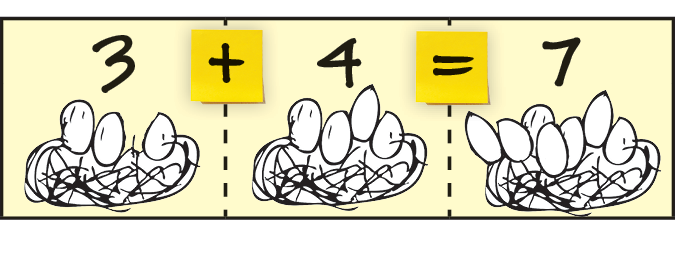
“One Pretty Pig”
Enjoy this version of the lively song (“One Elephant”). A bank is an edge of a waterhole or stream. Imagine how a pig on a muddy bank would have slip-slidey fun.
One pretty pig went out to play,
Out on a muddy bank one day.
She had such slip-slidey fun,
She called for another pretty pig to come.
Reading with your child
Farm Animals
Show the title page and have your child identify the animal in the photo. Say: Some people call this animal a pig and others call it a hog. Find Hogs in the Table of Contents. Read page 14 and the caption that goes with the photograph. Ask: How would you describe a hog?
Penelope Pig
This fiction book is also about pigs. After listening to the musical text, ask: How are real pigs different from Penelope and her pal Polly?
Listen and Write
- Say: Pig begins with P. Then write the sentence.
- Have your child practice saying the letter name and sound.
- Model writing the letter.

P (pull down, circle around to the middle)
p (pull down, circle around to the middle)
- Have your child practice writing the letter in the air or on the floor.
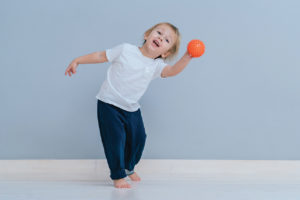
Bottle Bowling
Put five dot stickers on the floor (two in a front row and three in a back row). Show your child how to stand a plastic bottle on each sticker. Have your child roll a soft ball toward the bottles as if they were bowling pins. Count how many bottles are knocked down and how many are standing. Stand the bottles up that were knocked over and roll again. Ask: Can you knock over all five bottles at one time?
Moo
Teach your child this new calming strategy.
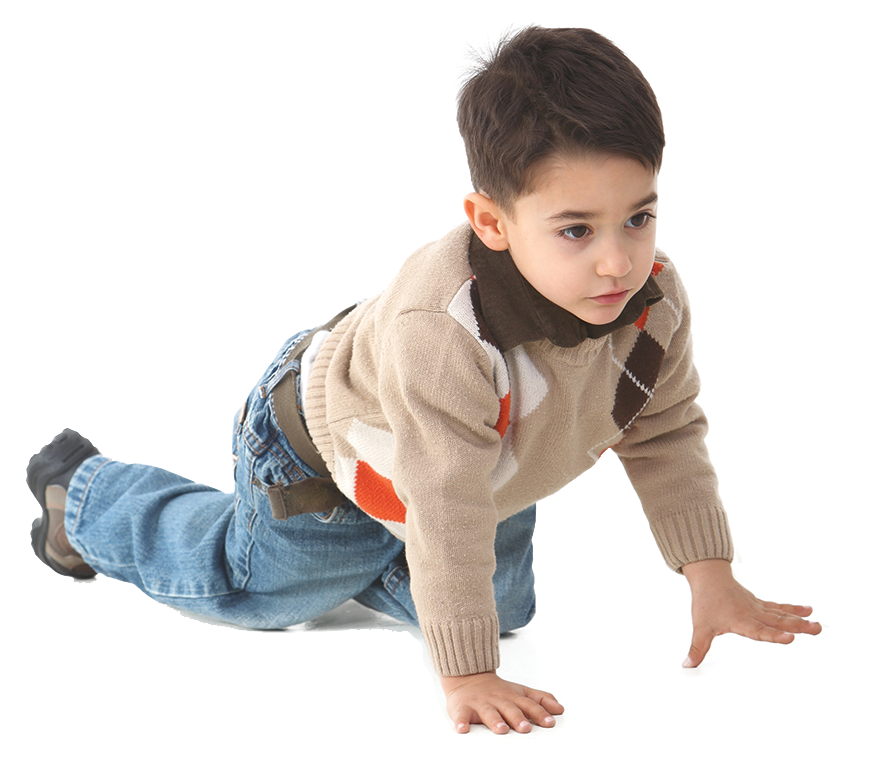
- Get down on all fours like a cow.
- Inhale a deep breath.
- Exhale slowly while making a soft mooing sound.
- Repeat three times, each time mooing more softly and more slowly.
Spin the Spinner
Have your child help you create a number spinner. Divide a paper plate into four equal sections. Draw a different number of dots in each section (1-4). Put a paper clip on the tip of a pencil and then place the tip in the center where the lines cross. Have your child flick the paper clip to make it spin. When the clip stops spinning, count the dots in the section and add that many small items (pennies, shells, pebbles) to an empty egg carton. Continue spinning and filling each section until the carton is full.

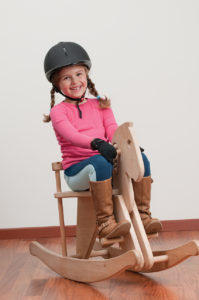
Gallop and Trot
Talk about riding a horse. Demonstrate some horse movements (galloping, trotting, and loping). Have your child imitate each move. Then show how to saunter like a cow. After your child tries sauntering, ask: How are the horse’s moves different than the cows? Which moves are faster?
Reading with your child
In the Cow’s Backyard
Show the book and ask: Is this book about a real cow or a make-believe cow? Do cows really nap in hammocks? Read pages 2-7. Draw a T-chart. Label the columns animals and sounds. Have your child name the animals that climbed into the hammock and make the animal sounds. Record the information on the chart.
Farm Animals
Point to the second entry in the Table of Contents. Say: This word says Cattle. Cattle is a name for cows. Read the information about cattle on page 11. Then picture walk through the book and notice all the different kinds of cattle (cover; pp. 4, 8, 10). Read the captions to learn more about cattle. Ask: How are these animals alike and how are they different?
Listen and Write
- Say: Horse begins with H. Then write the sentence.
- Have your child practice saying the letter name and sound.
- Model writing the letter.

H (pull down, pull down, slide across)
h (pull down, curve over, pull down)
- Have your child practice writing the letter in the air or on the floor.
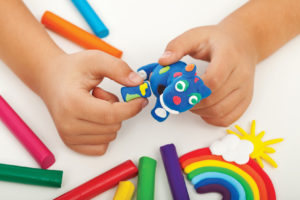
Clay Animals
Invite your child to create animals from clay or play dough. Help your child name the animals and point out their unique features.
Baa, Baa, Sweet Sheep
Teach this verse to your child. Add finger counting and appropriate hand motions.
Baa, Baa, sweet sheep. Have you any wool?
Yes, friend, yes, friend, three bags full.
One for mittens, one for a cap.
And one for the little girl (boy) with her hands in her lap.
Joining Groups
Remind your child how to flick the paper clip on the number spinner you created. Have your child flick the paper clip two times. For each spin, have your child count out a matching set of objects (cotton balls, pebbles). Help your child use these two sets to create and illustrate a number story by joining the two sets of counters. For example: There were three cows in the barn and three cows in the pasture. The farmer has six cows altogether. Repeat the activity with two new spins.
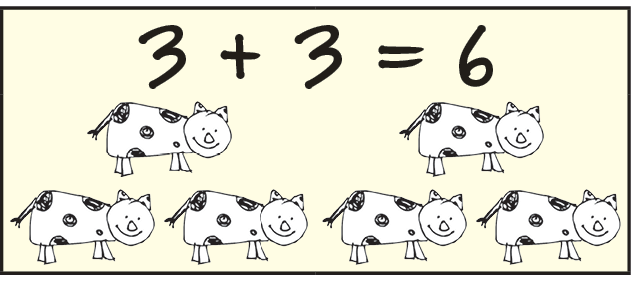
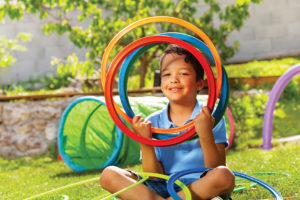
Five Through the Hoop
Mark a throw line on the floor or patio with a piece of masking tape. Hold a hoop or cardboard circle upright about three feet from the throw line. Your child will stand behind the throw line and toss five foam balls or tightly rolled socks through the circle. After five throws, stop and talk about how many made it through the hoop and how many did not.
Reading with your child
Farm Animals
Say: Today we will read about goats and sheep. Turn to pages 16-17. Ask: Are the animals in the photo sheep or goats? How can we know for sure? (read the caption) Read the information on page 17 to learn more these farm animals. Go on a photo hunt through the book to find a photo of a goat (page 7).
Gus the Goat
Listen to this silly song about Gus the
Goat. Ask: Why do you think this little
book was written? Was it to give facts
(information) about goats? Was it to use many words that begin with the sound of the letter g?
Listen and Write
- Say: Goat begins with G. Then write the sentence.
- Have your child practice saying the letter name and sound.
- Model writing the letter.

G (circle around and up, slide across)
g (circle around and up, pull down, curve up).
- Have your child practice writing the letter in the air or on the floor.
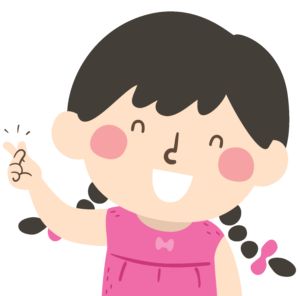
Syllable Game
Show photos of farm animals one at a time or call out a farm animal’s name. Then help your child clap, snap, and tap the syllables in the name.
Visiting the zoo is one way to meet wild animals. This week your child will learn interesting facts about zoo animals.
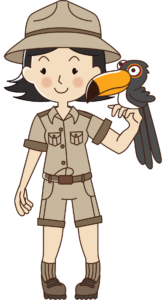
Wonderful Zookeeper
Taking care of animals on the farm, in your home, or at a zoo is an important job. Ask: What are some of the things a zookeeper would need to do to care for the animals? Use your child’s ideas to adapt the verse “Wonderful Woman.” Repeat it together.
A wonderful zookeeper lived at the zoo.
She had so many animals
She knew exactly what to do.
She ______ them, she ______ them,
And put them to bed.
“I love you, I love you” is what she said.
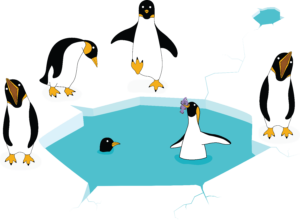
Separating Groups: Model the Story
Tell your child this number story: In the zoo’s penguin exhibit, there are six penguins bathing in the sun. Then two of the penguins jump into the pond. Have your child retell the story. Use counters (such as cotton balls) to model and act out the story. Ask: How many penguins are still bathing in the sun? Count to confirm the correct answer.
Zookeeper Says
Gather family members and play a game of “Zookeeper Says” (variation of “Simon Says”). You be the zookeeper. Give commands that require players to move and make sounds like zoo animals (chatter like a chimp, jump like a kangaroo, swing like a monkey in the tree). Remind your child to do the action only when you say: The zookeeper says…
Reading with your child
Welcome to Zippity Zoo
Show the cover of the book and have your child name the animals in the photos. Read the title. Explain that the title is part of an invitation to visit a zoo. Zippity Zoo is not a real place, but the facts about the animals in the book are real. Read page 3 for the complete invitation. Then take a picture walk through the book to see some of the animals you will be learning about this week. Talk with your child about your experiences visiting a zoo.
Listen and Write
- Say: Zoo begins with Z. Write the sentence.
- Have your child practice saying the letter name and sound.
- Model writing the letter.
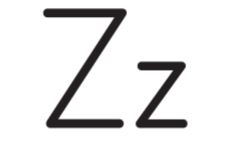
Z (slide across, slant down, slide across)
z (slide across, slant down, slide across)
- Have your child practice writing the letter in the air or on the floor.
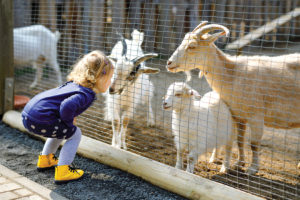
Talking with Animals
Talk with your child about communicating with animals. Begin by talking about your pets and familiar animal friends. Then extend the activity by imagining the questions you might ask a zoo animal.
- How do you talk with (name of pet or animal friend)? Does it understand you?
- How does (name of pet or animal friend) communicate with you? Does it use words, sounds, movements? Do you understand it?
- If you could talk with an animal in the zoo, what questions would you ask?
Monkey See, Monkey Do
Sit face to face with your child. One of you will be the lead monkey and one will be the copycat monkey. The lead monkey does a monkey movement, and the copycat monkey copies the movement. Monkey actions might include: peeling a banana, eating a banana, touching nose, scratching stomach, bouncing, picking fleas, dangling arms. Ask: What would it be like if a monkey lived at our house?
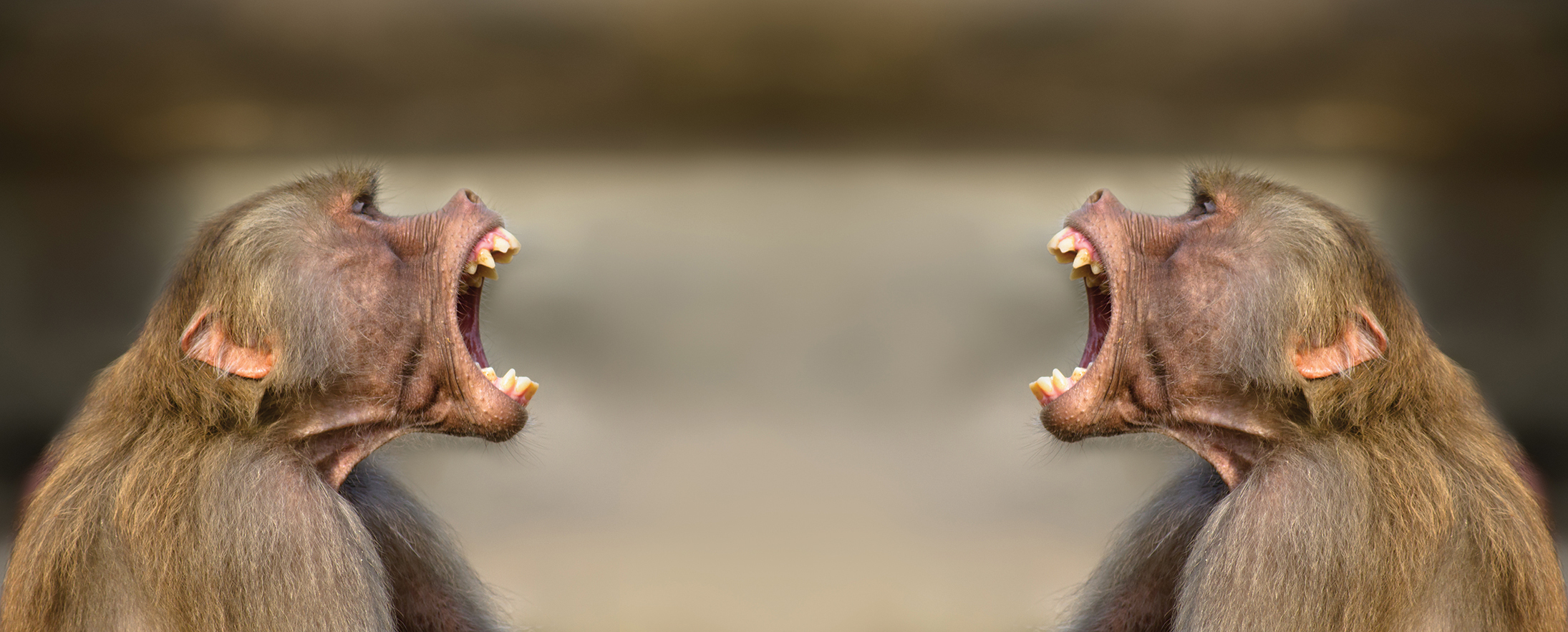
Illustrate the Story
Have your child retell the penguin number story you introduced yesterday. Think together about how to illustrate the story. Divide a sheet of paper into three equal sections and illustrate the beginning (six penguins in the sun), middle (two jump into the pond), and end (four penguins left in the sun).
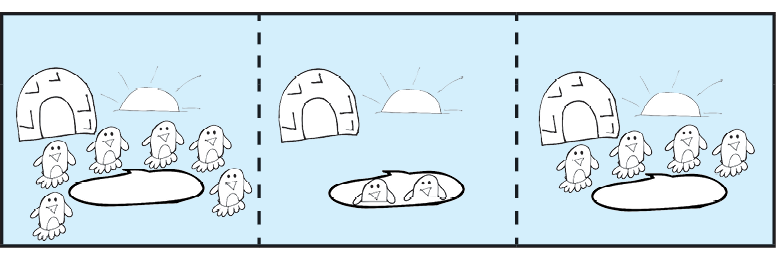
Ask: How did the number of penguins change from the beginning to the end? (the number decreased or got smaller) Save the drawing for tomorrow.
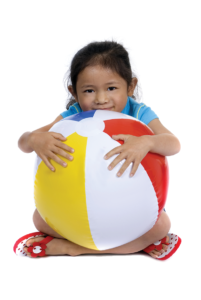
Elephant Soccer
The object of this game is to keep the beachball inside a playing area. Find a large open space indoors or outdoors. Mark a large square or circle as the playing area. Give your child a paper-towel tube to use as an elephant’s trunk and keep one for yourself. Toss a beach ball to your child. The two of you will use your “trunks” to keep the ball inside the playing area.
Reading with your child
Welcome to Zippity Zoo
Remind your child that sometimes we use books to find information. Say: Today we will find information about (research) chimpanzees and monkeys. Read pages 4-5. Notice all of the different kinds of monkeys in the photos. Explain that informational books sometimes have a special section with information. It is called a glossary. Turn to page 22 and read the title of the page. Point to the photographs (1-6). Match the numbers by the photos with the numbers by the facts to learn who’s who at the zoo.
Listen and Write
- Say: Monkey begins with M. Write the sentence.
- Have your child practice saying the letter name and sound.
- Model writing the letter.
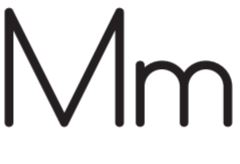
M (pull down, slant down, slant down, pull down)
m (pull down, curve over and down, curve over and down)
- Have your child practice writing the letter in the air or on the floor.
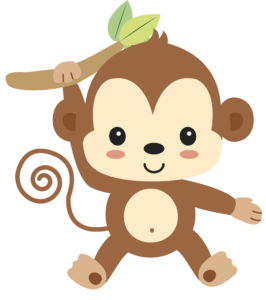
“Ten Little Monkeys”
Enjoy singing and moving to the song. Point out that the verse is a number story. Use counters to add up all of the monkeys to see how many there are in all. (one monkey doing tricks + two monkeys picking up sticks + three monkeys standing in lines + four monkeys swinging on vines = ___monkeys)
Elephant Bathing
Teach your child the calming strategy Elephant Bathing.
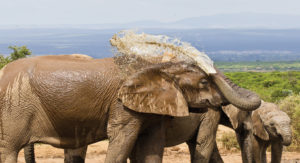
- Interlace fingers and stretch your arms out in front of your body. This is your trunk.
- Bend down, taking in a deep breath as you pretend to suck water into your trunk.
- Swing your trunk over one shoulder and slowly exhale as you shower your back with water.
- Repeat several times, alternating shoulders.
Write a Number Sentence
Look at the number story illustration you and your child created yesterday. Use the three-section layout of the illustration to help your child sequence the events. Use cotton balls to show how the number decreased from the beginning to the end. Have your child write a numeral to show the number of penguins in each section. Write a – sign and an = sign on stick-on notes. Explain that – (minus) means that a group of objects has been separated and = means equal to. Add the stick-on notes to the illustration to form the sentence: 6 – 2 = 4.
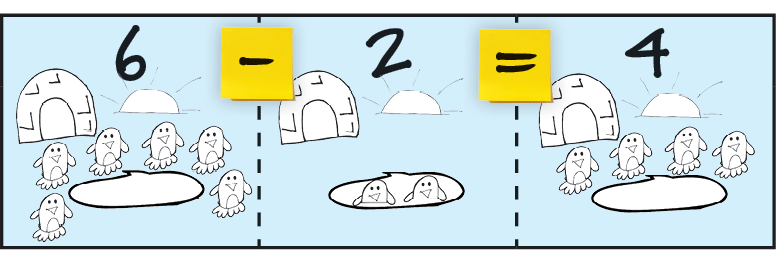
One Happy Bear
Enjoy this version of the “One Elephant” song. Place a rope on the floor. Start with your child walking on the rope like a tightrope. After each verse, add a stuffed bear until your child can’t hold any more.
One happy bear went out to play,
Over at Zippity Zoo one day.
It had such fantastic fun,
It called for some other balancing bears to come.
Reading with your child
Welcome to Zippity Zoo
Today you will read about different kinds of bears. Show the photos on pages 16-17. Read the information. The last word (lair) is probably a new word for your child. It means home or den. Have your child tell how the three kinds of bears in the photos are alike and how they are different. Turn to the glossary at the back and read a new fact about each of the bears (#23 spectacled bear, #24 polar bear, #25 black bear).
Listen and Write
- Say: Elephant begins with E. Write the sentence.
- Have your child practice saying the letter name and sound.
- Model writing the letter.

E (pull down, slide across, slide across, slide across)
e (slide across circle around and up)
- Have your child practice writing the letter in the air or on the floor.
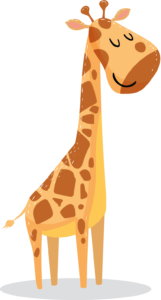
Zoo Riddles
Provide clues that will help your child identify a specific zoo animal. For example, you might say: I am thinking of an animal with long, skinny legs. What is it? If your child needs additional help, say: It has spots and a very long tongue. (giraffe)
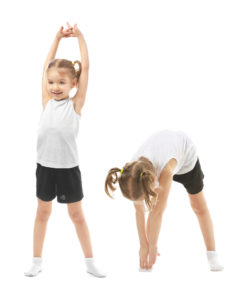
Bend and Stretch
Have your child pretend to be a giraffe with a long neck and long legs.
- Stretch tall as you inhale slowly.
- Spread your legs apart and bend low as you exhale slowly.
- Repeat several times.
Spin the Spinner and Take From
Have your child place five counters (cotton balls, pennies, or pebbles) in each hole of an egg carton. Remind your child how to use the paper plate spinner you created last week. Have your child flick the paper clip to determine how many items to remove from a hole. Each time your child spins and removes counters, ask: How many counters are in the hole now? Spin and remove some counters from every hole.
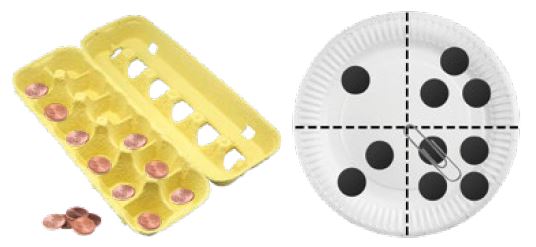
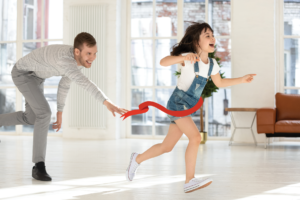
Catch a Tiger’s Tail
This is a game of chase. Invite family members to join in the fun. Choose one hunter (the other players will be the tigers). Tie a streamer (tail) around the waist of each tiger. The hunter attempts to run after a tiger and grab its tail. Before the game begins, remind players to use safe touches.
Reading with your child
Welcome to Zippity Zoo
Today you will read about zebras. Turn to pages 6-7. Talk about the photos of the zebras under the tree. Say: Zebras stay together in groups to camouflage themselves from their enemies. When they are in a group, their stripes blend together and make it difficult for their enemies to pick out a target. Write the word camouflage and say: Camouflage means blending in with the environment. The glossary has an interesting fact about the zebra’s stripes. Have your child find the zebra’s photo, the numeral on the photo, and then the same numeral in the list of facts (#8).
Listen and Write
- Say: Zebra begins with Z. Write the sentence.
- Have your child practice saying the letter name and sound.
- Model writing the letter.

Z (slide across, slant down, slide across)
z (slide across, slant down, slide across)
- Have your child practice writing the letter in the air or on the floor.
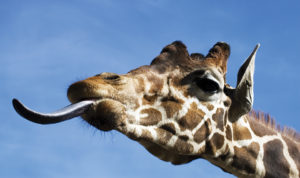
Giraffe Tongue
Cut a strip of black paper or black ribbon 19 inches long. This is about the same length as a giraffe’s tongue. Have your child look around your house for objects that are about the same length as a giraffe’s tongue. Have your child look in a mirror and compare the ribbon to his tongue. Ask: Why do you think the giraffe’s tongue is black? (Some zoologists believe the tongue is black to keep it from getting sunburned.)
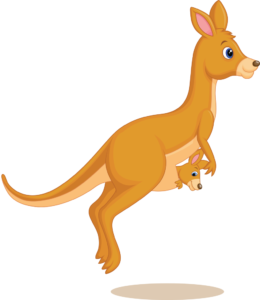
Kangaroo Breathing
Remind your child of some of the animal breathing strategies that the two of you have learned: Bunny Breathing, Elephant Bathing, Moo. Together, decide how you would create a kangaroo breathing strategy. Try it out. Ask: Would our new strategy help you calm down?
Create a Number Story
Create a new number spinner with sets of 4, 5, 6, and 7 dots in the sections. You will use the 4-7 spinner and the 1-4 spinner to create number stories. Have your child spin the 4-7 spinner. When the spinner stops, your child will count out that many cotton balls. Imagine the spinner stops on six dots, your child will take six cotton balls.
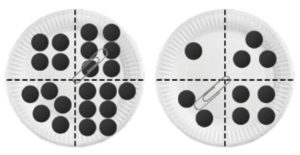
Next, your child will spin the 1-4 spinner and remove cotton balls. If the 1-4 spinner stopped on two dots, your child will remove two cotton balls from the set of six. Imagine a story to match the numbers: There were six polar bears on the ice. Two of the polar bears dove in the water. How many polar bears are still on the ice?
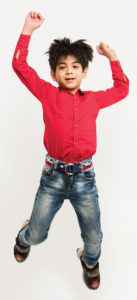
Kangaroo Jump
Draw a chalk line or use a rope to show how long 40 feet is. Explain that a kangaroo can jump 40 feet. Have your child stand at one end of the line and jump. Ask: Can you jump as far as a kangaroo? How many jumps do you have to make to move 40 feet?
Reading with your child
Welcome to Zippity Zoo
Today you will learn about wallabies and koalas. Both of these animals live in Australia. They carry their babies in pouches. Begin in the glossary and read #16 wallabies and #17 koalas. Then picture walk through the book to find pages with photos of these two animals. If possible, do an Internet search to find more photos. Ask: If you were a zookeeper, which animals would you like to take care of? Why?
Katy Kangaroo
This song reinforces the sound of the letter k at the beginning of words. Listen to the song and have your child signal each time she hears a /k/.
Listen and Write
- Say: Kangaroo and koala begin with K. Write the sentence.
- Have your child practice saying the letter name and sound.
- Model writing the letter.

K (pull down, slant down, slant down)
k (pull down, slant down, slant down)
- Have your child practice writing the letter in the air or on the floor.
Counting Forward and Backward
Create a large 1-10 number line by taping numeral cards to the floor or writing with chalk on an outdoor patio. Have your child jump onto each numeral and say the number. Say: You are counting forward. Take your child’s hand and assist her in jumping backward, counting from 10 to 1. Ask: If you start at seven and hop back one number, which number will you be standing on?
This week you and your child will explore the habits of ants, termites, bees, wasps, mosquitoes, ladybugs, beetles, dragonflies, and fireflies.

Butterfly Breathing
Do the calming strategy Butterfly Breathing. Have your child inhale and exhale slowly while lifting and lowering arms (butterfly wings). Say: A butterfly’s wings are fragile (easily damaged) so lift and lower them gently.
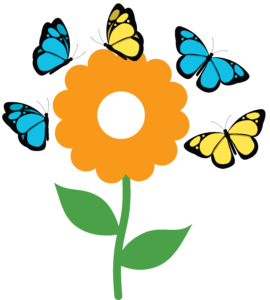
How Many Altogether?
Tell your child the following number story: There are three blue butterflies and two yellow butterflies circling a flower. How many butterflies are there altogether? Have your child retell the story. Then illustrate the story together. Draw a set of three blue butterflies and two yellow butterflies. Ask: How can we figure out how many butterflies there are altogether?
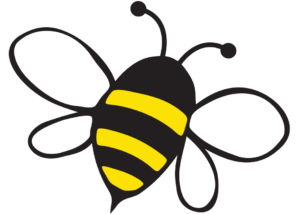
“All Around My Yard”
Listen to the song and name the bugs in the different verses. Listen again and have your child move to the rhythm of the music like the bugs named (firefly, bee, ant, cricket, caterpillar, worm). Ask: What different moves do the bugs make? What different sounds do they make?
Reading with your child
Edie’s Backyard Bugs
Explain that insects can be found everywhere: on farms, in woodlands and ponds, and even in your backyard. This book is about a little girl who loves bugs. She wants to be an entomologist (a scientist who studies insects) when she grows up. Have your child repeat the word entomologist. Read pages 2-7 to introduce Edie. Ask: What did you learn about Edie? Would you like to be an entomologist? Why or why not? Take a picture walk through the book and look at the photos of the insects and bugs. Tell your child you will read about the different bugs during the next two weeks.
Listen and Write
- Say: Insect begins with I. Write the sentence.
- Have your child practice saying the letter name and sound.
- Model writing the letter.

I (pull down, slide across, slide across)
i (pull down, dot)
- Have your child practice writing the letter in the air or on the floor.
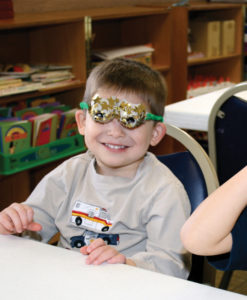
Bug-Eye Glasses
Bugs sometimes have large eyes that protrude (stick out) from their heads. Carefully place a two-cup section of an egg carton on a table and cut a hole in the bottom of each section to create eye holes. Give your child this two-cup egg carton and some craft supplies (sequins, jewels, feathers, markers, foam shapes) to make “bug eyes.” Punch holes at the side of each cup and attach chenille stems to create ear pieces to hold the bug eyes on your child’s face.
Calm Bee Wings
Teach your child Calm Bee Wings. (Bees normally flap their wings rapidly, so pretend to be calm bees hovering in slow-motion.)
- Fold arms in and tuck hands in your arm pits.
- Hold out your elbows.
- Circle your elbows slowly like a calm bee in slow motion.
- Slowly inhale and exhale with each flap.
The Missing Part
Challenge your child to figure out the missing part of this number story: There are five butterflies. Four butterflies are blue and the rest are yellow. How many butterflies are yellow? If your child struggles to solve the problem, suggest spreading apart five fingers on one hand on a sheet of paper. Count the fingers. Say: Five fingers, five butterflies. Draw four blue butterflies above four fingers. Ask: How many fingers are left without a butterfly? (one, which would be yellow) Say: The missing part is one: four blue butterflies and one yellow butterfly make five butterflies in all.
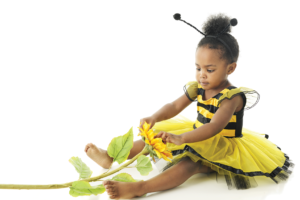
“Baby Bumblebee”
Have your child buzz about the room like a baby bumblebee as you listen to the song. Invite your child to retell the story in the song (the child catches a baby bee, the bee stings the child, the bee says “sorry,” the child lets the bee go). Ask: Is this a true story? Do bumblebees really sting? How can we keep from being stung? Do you think letting the bee go was the correct thing to do?
Reading with your child
The Song of the Teeny Tiny Mosquito
Have your child point to the mosquito on the cover illustration. Say: This is a drawing of a mosquito. Point out its six legs, two wings, long mouth, and three body parts. Read the book to find out what animals like to eat. Ask: What animal likes to eat mosquitoes and other insects?
“The Insect Song”
Explain that just like we have names for our body parts (head, shoulders, knees, toes), an insect’s three body parts have special names: head, thorax, and abdomen. Sing the song about your child’s body parts: “Head, Shoulders, Knees, and Toes.” Then teach your child the “The Insect Song.” Each day as the two of you learn about insects, identify the insect’s body parts in the photos.
Listen and Write
- Say: Thorax ends with x. Write the sentence.
- Have your child practice saying the letter name and sound.
- Model writing the letter.

X (slant down, slant down)
x (slant down, slant down)
- Have your child practice writing the letter in the air or on the floor.
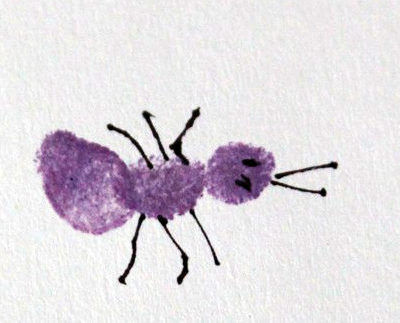
Fingerprint Ants
Help your child create fingerprint ants. Press one finger on a stamp pad or in a small puddle of paint. Make three connected fingerprints to make the ant’s body. Use a marking pen to add three pair of legs to the middle section (thorax). Add antennae to the head.
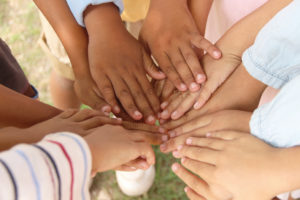
“All Together”
Explain that groups of insects work together to build homes and gather food. Ants and termites are good examples. Listen to the song and talk about how it is important for human families as well as insect and animal families to work together and live in peace.
Shake and Spill
Have your child count five pennies into a plastic cup. Then, shake the cup and spill the pennies onto a paper plate. Challenge your child to figure out how many pennies landed on heads and how many landed on tails. Make a chart divided into two columns to record the results of the spill. Continue shaking and spilling. For each spill, write the number of pennies that are heads and tails in the appropriate column.

Ladybug, Fly Away
Give your child two red plastic plates or two red cardboard circles. Designate one corner of your play space as “home.” If siblings are playing the game, designate different corners for each player. Draw a circle in the center of the play area where you will stand. Have your child (and any other players) stand in the circle with you. Say: Ladybug, ladybug, fly away home. Your child should hold one plate in each hand and flap the plates up and down while “flying” home. After a moment, call: Ladybug, ladybug, come back here. Repeat several times.
Reading with your child
Edie’s Backyard Bugs
Remind your child about Edie and her interest in bugs. Turn to pages 10-11. Explain that these pages show two beetles. Point to the black beetle on the left page and the spotted beetle on the far right. Say: Let’s read to find out more about these two insects. Read Edie’s words. Then look closely at the photographs. Point out the insect body parts. The long bug in the center photograph is a pink ladybug larva. Explain that a larva is a young ladybug. Just like a human baby changes and looks different as an adult, a ladybug changes too.
Listen and Write
- Say: Ladybug begins with L. Write the sentence.
- Have your child practice saying the letter name and sound.
- Model writing the letter.

L (pull down, slide across)
l (pull down)
- Have your child practice writing the letter in the air or on the floor.
“Five Little Ladybugs”
Before you listen to the song, prepare five ladybugs. Cut five circles of red construction paper and add black dots or use plastic bottle caps. Line your ladybugs up in a group. Listen to the song and remove one ladybug from the line each time the lyrics say that a ladybug leaves. When the lonely ladybug calls her friends on the phone, return all of the ladybugs. Ask: How many ladybugs were on the shore at the beginning of the story? How many were on the shore at the very end?

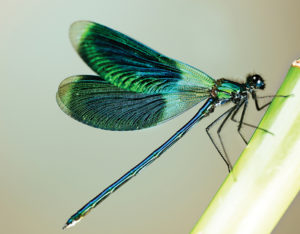
Dragonfly Wings
Have your child pretend to be a dragonfly flying gracefully around a pond on a summer day. Your child should inhale as the wings go up, glide for several seconds, and then exhale as the wings go down. Ask: How are a dragonfly’s wing movements different than a bee’s?
Finger Flash
Look at the chart you and your child created yesterday. Point out that each time you spilled the pennies, you had five pennies. While the number of heads and tails were different, there were always five pennies. Show pennies to demonstrate four heads and one tail make five altogether; three heads and two tails make five altogether, two heads and three tails make five altogether, and one head and four tails make five altogether. Ask: What if all five pennies were heads? How many would be tails? (0) Practice the different combinations of five with finger flashes. Ask: How many fingers are showing? not showing (folded down)?

Bug Moves
Challenge your child to think of and show different bug moves. For example, hop like a grasshopper, inch like an inchworm, zip like a mosquito, scurry like an ant, squiggle and squirm like a worm. The object of this activity is for your child to think about different ways bugs move and to practice moving her body in different ways. Say: You show you know what words mean as you move your body in different ways.
Reading with your child
Can You Move With Me?
As you read the book together, notice the words that name different kinds of actions (verbs). They are printed with a special font (lettering). For example, on page 2, the letters in wiggle, squiggle, and squirm look like they are moving! Encourage your child to point to the action words on each page by identifying the different font. Ask: Which little creatures in this book are insects and bugs?
Edie’s Backyard Bugs
Turn to page 8 to see a closeup photograph of a dragonfly. Read the text to learn about different ways that a dragonfly moves. Help your child demonstrate the moves so the words have meaning (hover: stay in one place in the air, fly backwards, do loop-de-loops: turn upside down to fly in big circles).
Listen and Write
- Say: Dragonfly begins with D. Write the sentence.
- Have your child practice saying the letter name and sound.
- Model writing the letter.

D (pull down, circle around to the bottom)
d (circle around and up, pull down)
- Have your child practice writing the letter in the air or on the floor.
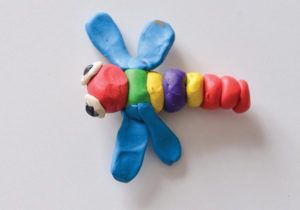
Play Dough Dragonflies
Have some fun creating play dough dragonflies. Connect colorful balls of playdough then add a head, eyes, and wings.

“I Wish You Well”
Remind your child that even though you are working at home, if someone you know is having a difficult time, you can send them good wishes. Think of someone you wish you could connect with. Play “I Wish You Well” and sing along.
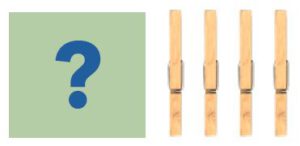
The Hiding Game
Have your child count out a set of five clothespins to represent a group of grasshoppers. Use a sheet of paper to cover up one or more of the clothespin grasshoppers. Each time you place the paper, ask: How many grasshoppers are hiding? How many are not hiding (can you see)? If your child is unsure of the number of grasshoppers that are hiding, refer to the chart you created yesterday that showed combinations of five fingers that were showing and not showing. Say: Pretend that your fingers were the grasshoppers. When ___ were showing, how many were not showing?
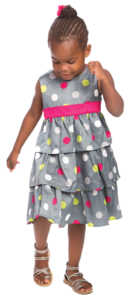
“Little Ants”
Imagine that you are in a line of ants marching from a picnic to your anthill. March to the rhythm of the music and join in the repeated refrain (With a hip, hop, happy hi, Won’t you join my song? Little ants are _ on.)
Reading with your child
Big Numbers
The main character in this book is an inchworm. When an inchworm moves, it arches its body instead of crawling along flat. It pulls its back up to its front and then extends its front end to move forward. Try this way of moving. Then listen to a funny story about one inchworm who liked to count big numbers.
Listen for the Same Sound
Have fun with insect alliteration (words that begin with the same sound). Say the following sentences and have your child identify the beginning sound that is repeated.
- Mobs of mosquitoes make me moan.
- Testy termites tap, tap, tap.
- Beautiful beetles bathe blissfully.
- Wimpy wasps waltz wildly.
Listen and Write
- Say: Termite begins with T. Write the sentence.
- Have your child practice saying the letter name and sound.
- Model writing the letter.
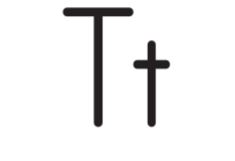
T (pull down, slide across)
t (pull down, slide across)
- Have your child practice writing the letter in the air or on the floor.
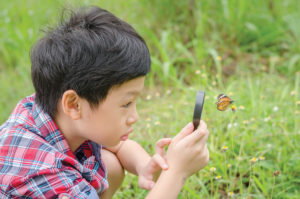
Bug Walk
Go on a bug walk with your child. Take a magnifying glass if you have one. Walk slowly and quietly in your yard or along your street. Observe the bugs, but do not disturb them. Remind your child that insects are living things and we should show compassion toward them.
This week you and your child will learn about more bugs and read about some other creepy crawlies like spiders and worms.

Continuing Daily Commitments
Remind your child that together you are responsible for keeping each other safe and working together. Think about the commitments that you have made in the past, such as using kind words, using helping hands, using a big voice, listening to other’s big voices. Take a moment to connect and decide on your commitment for today.

Itsy-Bitsy Climbs a Tower
Have your child make a tower of seven same-sized paper squares or stick-on notes. Tell this number story (word problem): The Itsy-Bitsy Spider climbed five squares on the tower. How many more squares does she have left to climb to reach the top? Have your child retell the story. Then, have your child walk her fingers up the tower, counting the squares, to figure out how many squares are left to climb.
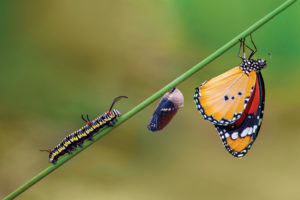
“Roly-Poly Caterpillar”
Listen to the song. Explain that the words tell about how caterpillars change and become butterflies. Act out the story: crawling to a corner, spinning a blanket (chrysalis), sleeping, waking to find beautiful wings, flying away as a butterfly.
Reading with your child
Edie’s Backyard Bugs
Read pages 16-19. Explain that on these pages Edie describes how a caterpillar or a moth changes as it grows (caterpillar [pupa], chrysalis, butterfly; caterpillar, cocoon, moth). Ask: How is the way a butterfly changes as it grows different from the way a baby bird changes? What do you think is surprising about the butterfly’s changes?
Listen and Write
- Say: Butterfly begins with B. Write the sentence.
- Have your child practice saying the letter name and sound.
- Model writing the letter.

B (pull down, circle around to the middle, around to the bottom)
b (pull down, back up and around)
- Have your child practice writing the letter in the air or on the floor.
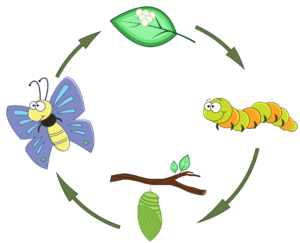
A Life Cycle
Draw four circular arrows (clockwise). Explain the life cycle of the butterfly. Begin by drawing eggs (small round circles on a leaf) at the top of the circle. Continue around the circle drawing a caterpillar on the right side, the chrysalis on the bottom, and the butterfly on the left side. Point to each drawing as you talk about that part (stage) of the life cycle. You might say: First, there were some tiny eggs on a leaf. A caterpillar hatched from one of the eggs. It ate the leaf and many other leaves. Then it attached itself to a branch and spun a blanket like a shell and slept. Soon the chrysalis started to move. It broke apart and a butterfly pulled itself out. It spread its beautiful wings and flew away. Then the butterfly laid some tiny eggs on a leaf and a caterpillar hatched from an egg… Move your hand to show how the changes repeat (occur in a cycle).
Here Is the Beehive
Do this fingerplay with your child.
Here’s the beehive, where are the bees?
(hold child’s fist)
Hidden away where nobody sees.
(shrug shoulders)
Watch and you’ll see them come out of the hive.
BZZZZZZZZZZZZZZZ
(open one finger at a time)
I’ll catch them and keep them alive.
(catch fingers in your hand)
Itsy-Bitsy Needs Climbing Shoes
Show the wolf spider on page 21 of Edie’s Backyard Bugs. Carefully count its eight legs. Have your child count and place eight clothespins around a paper plate (place four on each side). Tell this number story: Itsy-Bitsy has six climbing shoes. Does she have enough shoes for each foot? Have your child match six pennies (shoes) to each clothespin. Point to the two clothespins without pennies. Ask: How many more shoes does she need? Write a number sentence to go with the story: 6 + 2 = 8.
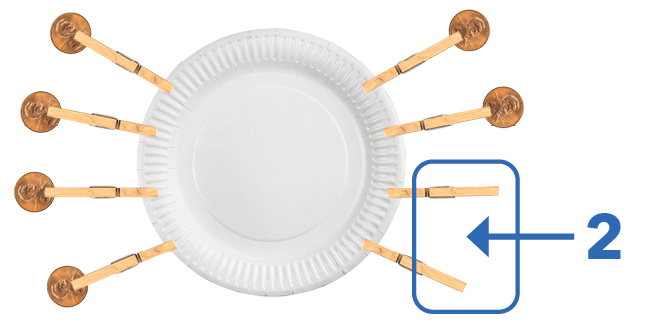
Run, Bounce, Jump
Jumping insects, like grasshoppers and crickets, move with a catapulting motion. Try imitating this motion by running, bouncing, and then jumping while swinging your arms up to help lift your weight. Have your child pretend to be a grasshopper and run, bounce, and jump. Ask: How is this move different than your regular jump? Does this help you make a long jump or a high jump?
Reading with your child
Edie’s Backyard Bugs
Turn to page 23 and have your child point to the grasshopper. Ask your child which body part helps these powerful jumpers. Read the information about a grasshopper’s jump. Enjoy thinking about being able to jump half the length of a football field! Continue reading the information about grasshoppers and talk about how grasshoppers make sounds. Have your child rub her knees together. Ask: Do you hear a grasshopper sound?
Sara Sidney’s Runaway Adventure
Show the cover of the book and have your child recall what this book is about. Point to the cricket in the drawing. Turn to pages 16-17. Read the text. Have your child repeat the name of the insect. Ask: Have you ever heard a cricket sing? How did the cricket’s song help Sara Sidney?
Listen and Write
- Say: Jump begins with J. Write the sentence.
- Have your child practice saying the letter name and sound.
- Model writing the letter.

J (pull down, curve up)
j (pull down, curve up, dot)
- Have your child practice writing the letter in the air or on the floor.
Insect Checklist
Explain that insects have six legs, two antennae, and three body parts. On a notecard, draw a small picture to show each attribute. Say: If we see a creature with these three things, we will know that it is an insect. Practice using your new “checklist.” Ask: Is a grasshopper an insect? Use a photo on page 23 in Edie’s Backyard Bugs to confirm that it has all three attributes, so it is an insect.
Can of Worms Greeting
Review this partner greeting called Can of Worms.
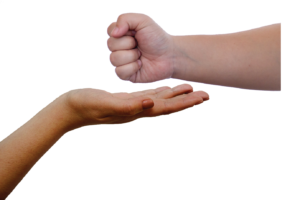
- Sit facing one another, holding hands out with right palms up.
- Put the fist (representing a can of worms) of the left hand on top of your child’s palm.
- Count to three and let the worms spill out (tip your fist and wiggle your fingers).
- Giggle together.
Spider or Ladybug?
Help your child fold a paper plate in half. Have your child recreate the clothespin spider from earlier this week, placing four clothespins on each side (eight legs altogether). Say: A ladybug is an insect. It has six legs. How can we change our clothespin spider to make a ladybug? Help your child solve this problem. Perhaps she will take off the eight clothespins and replace them with six or perhaps she will count down from eight to six and remove two clothespins. Write a matching number sentence: 8 – 2 = 6.

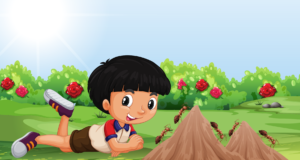
“My Busy Garden”
Have your child pretend to be the bugs in this song (digging, buzzing, spinning, chomping) as you listen to the lyrics.
Reading with your child
Garden Snail
Before this activity, copy the verse.
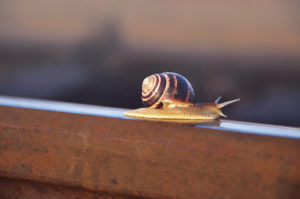
Slowly, slowly, very slowly goes the garden snail.
Slowly, slowly, very slowly up the garden rail.
Talk with your child about snails. Prompt the discussion with questions like these:
- What do you know about snails?
- How does a snail move?
Show the verse to your child and read it slowly as you point to the words. Have your child look for words in the verse that are repeated.
Listen and Write
- Say: Snail begins with S. Write the sentence.
- Have your child practice saying the letter name and sound.
- Model writing the letter.

S (circle around and down, circle around and up)
s (circle around and down, circle around and up)
- Have your child practice writing the letter in the air or on the floor.
Find the Rhyme
Give your child a word, repeat the sentence, and have your child identify the rhyming words. To make the game active, have your child pop up each time he hears a rhyme.
- snail: Abigail Snail said to the whale: I like your tail. The whale said to the snail: It makes a good sail.
- slug: A slug is a bug in need of a hug.
- worm: The worm said: Why do you treat me like a germ?

Eye Rest
Practice this familiar calming strategy. Say: You have two eyes, but most spiders have eight eyes. Even with eight eyes, they don’t see very well. They use sounds and movements to guide them instead of what they see. As you do the Eye Rest, breathe in and out slowly as you become aware of the sounds and movements around you.
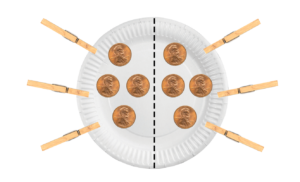
Make It Equal
Have your child place three clothespins on each side of a paper plate that has a crease in the middle to be the six legs on a ladybug. Have your child spin the 1-4 dot spinner to determine how many dots (pennies) to place on one side (wing) of the ladybug. Say: The spots on a ladybug’s wings should be the same (the same number in the same position—symmetrical). Challenge your child to create a symmetrical pattern on ladybug’s second wing.
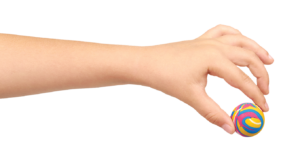
Hoppers
Write alphabet letters on the patio with chalk or use markers to write them on a large paper. Have your child drop or bounce a hopper (small bouncy ball like a ping-pong ball or rubber ball) and try to hit a letter. When the ball touches a letter, your child should call out the letter’s name. Ask: How do you control the bounce of the ball? Note: The size of the ball will determine how many letters to write and how far to place them apart.
Reading with your child
Edie’s Backyard Bugs
Show this now familiar informational book to your child. Picture walk through the pages and read information about the bugs your child is interested in learning about. Be sure to notice the spider on page 21. Ask: Is the spider an insect? (No, it has eight legs.) After reading page 24, ask: What bugs do you think live in our backyard? Would you like to study bugs like Edie? Why?
Listen and Write
- Say: Spider begins with S. Write the sentence.
- Have your child practice saying the letter name and sound.
- Model writing the letter.

S (circle around and down, circle around and up)
s (circle around and down, circle around and up)
- Have your child practice writing the letter in the air or on the floor.
Feeling Vibrations
Tell your child that although most spiders have eight eyes, they cannot see well and they have no ears. Spiders feel vibrations through the tiny hairs on their legs. Ask: How do you think the spider knows there is a bug caught in its web if it can’t see or hear the bug?
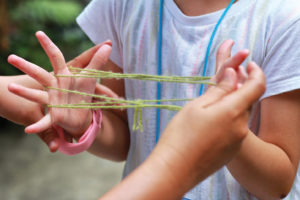
- Loop a string or piece of yarn between your child’s hands as if it were a spider’s web.
- Have your child close her eyes.
- Tap one of the strands of string gently.
- Ask: Can you feel a vibration?
- Touch a different spot.
- Ask: Is there something caught in your web?

“You Are My Sunshine”
Go outside with your child and feel the sunshine on your faces. Take time to confirm how important your child is to you. Look directly at your child as you sing along with the words of this song.
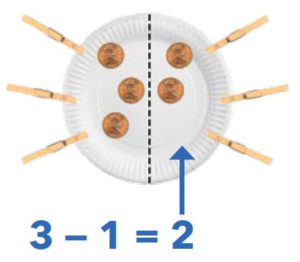
The Copy Game
Use the ladybug paper plate your child created yesterday to introduce a new game. Have your child spin the 1-4 dot spinner and place the number of pennies (dots) on the left wing to match the numeral where the paper clip stops. Repeat to add pennies to the right wing. Count the number of pennies on one wing (left or right) and change the number on the other wing so the two sides are equal. Ask: Will we need to remove pennies or add pennies? How many?
Insect Marching Band
You can make insect sound makers for your band out of common household items:
- Hum through an empty toilet paper tube to imitate buzzing bees.
- Rub a stick over the teeth of a comb to imitate crickets.
- Tap two sticks together to imitate beetles.

Once you and your child and other family members have made your sound makers, march around together playing them.
Reading with your child
Can You Move With Me?
Write the words worm and bee on a paper or index cards. Draw a simple illustration by each word. Show the words to your child and ask: What did I draw? What words did I write? Say: Great! You used the pictures to help you read the words. Turn to page 2. Help your child find the word worm in the text. Encourage your child to name the first letter of worm. Repeat with bee on page 12.
Listen and Write
- Say: Worm begins with W. Write the sentence.
- Have your child practice saying the letter name and sound.
- Model writing the letter.

W (slant down, slant down, slant down, slant down)
w (slant down, slant down, slant down, slant down)
- Have your child practice writing the letter in the air or on the floor.
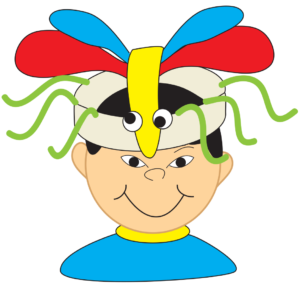
Crazy Bug Hat
Help your child create a crazy bug hat and then create one for yourself too. Cut a headband to fit your child and provide craft supplies, such as scraps of construction paper, yarn, chenille stems, feathers, wiggle eyes, buttons, pom-poms. Ask: What will you name your crazy bug? How would it move? Sound? What would it eat?

